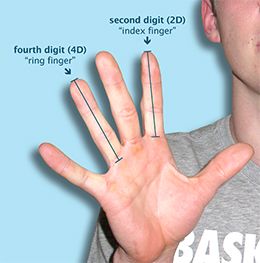10 August 2017
 Take a minute to look at your hands and pay special attention to the difference in length between your index finger and ring finger. This is your digit ratio.
Take a minute to look at your hands and pay special attention to the difference in length between your index finger and ring finger. This is your digit ratio.
A new study by the University of South Australia’s Dr Grant Tomkinson and his son (year 11 student, Sacred Heart School USA) Jordan Tomkinson, has found adolescent boys with lower digit ratios are better at sports.
The research paper Digit ratio (2D:4D) and muscular strength in adolescent boys by Jordan M. Tomkinson and Grant R. Tomkinson has been published in the Journal of Early Human Development and explores the difference in length between one’s index finger and ring finger, and a possible link to muscular strength.
Dr Tomkinson explains, “The ring finger in males is typically longer than the index finger, whereas the fingers are about the same length in females.
“There is some indirect evidence that this digit ratio of the length of the fingers, is determined during early fetal development by testosterone – the more testosterone the fetus produces, the longer the ring finger, so the smaller the digit ratio,” he says.
“Testosterone is the natural steroid hormone that enhances sport, athletic and fitness test performance. In general, people with smaller digit ratios are better athletes.
“For example, people with lower digit ratios tend to be better professional soccer players, basketball players, middle-distance runners, sprinters, fencers, sumo wrestlers, rugby players and rowers.
“Our study shows that boys with lower digit ratios have better handgrip strength and this is irrespective of their age or body size.”
The study is the first to quantify the relationship between the digit ratio and muscular strength in adolescent boys and found that the relationship likely reflects the long-term benefits of prenatal testosterone especially its effect on growth and development of the musculoskeletal system.
During the study, 57 males aged 13-18 from Sacred Heart School (East Grand Forks, USA) participated by recording their age, digit ratio, body mass and right handgrip strength.
The report says the findings may predict performance.
“Given that muscular strength is an important determinant of success in many youth sports and athletic events, our finding suggests that the digit ratio may predict performance in youth sports and athletic events requiring high strength.”
With muscular strength also an important indicator of good health, the study also suggests adolescent boys with lower digit ratios, have better general health.
Media contact: Georgia Aish mobile: +61 413 314 726 email: georgia.aish@unisa.edu.au


